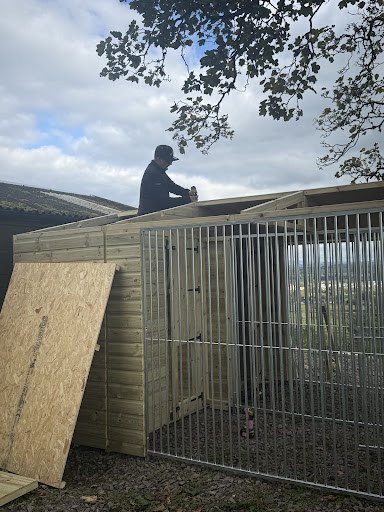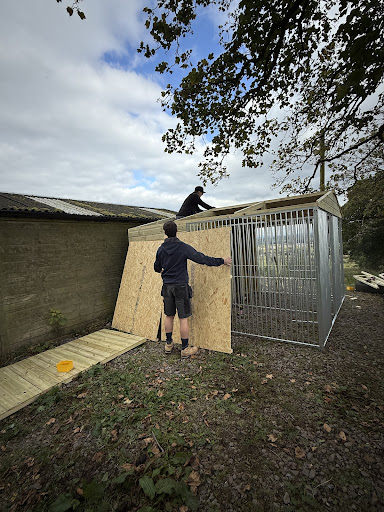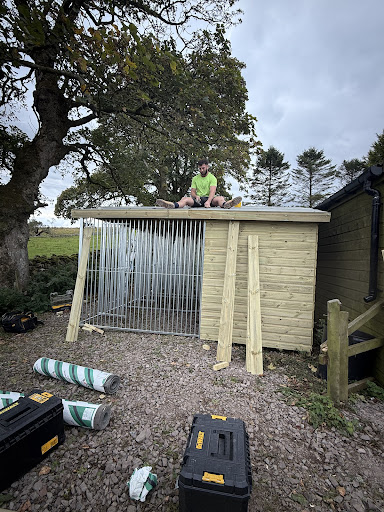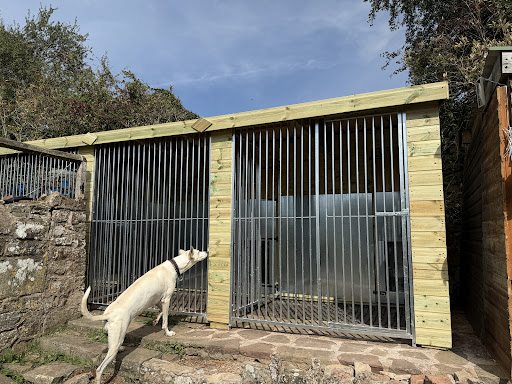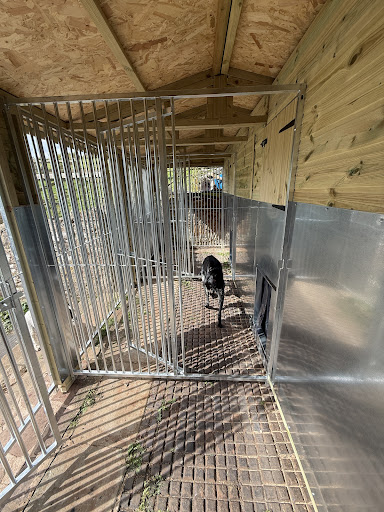Outdoor dog kennels have a lot of benefits that may be particularly advantageous to specific breeds. For example, some dogs, like Siberian Huskies, may thrive on staying outside most of the time. Other breeds, like the cockapoo, may need extra protection while hanging outside due to their small stature. Benchmark Kennels has the perfect selection of sizes for every breed and size of dog.
Outdoor dog kennels offer the perfect solution for pet owners looking to provide their dogs with a safe refuge while spending time outdoors. However, you may have a challenging time getting specific breeds to utilise their kennel time. The trick is to lean into their unique breed traits to make the outdoor kennel a relaxing and positive place for them. We’ll go over some of the top tricks and tips for getting your pet to utilise their time in the kennel.
The Basic Benefits of Outdoor Dog Kennels
Why should you get an outdoor kennel for your dog? There are a lot of reasons why pet owners should consider purchasing an outdoor kennel. Whether you’re looking for a protective place for your small breed or you want an enclosure that suits your rambunctious pup, outdoor kennels come with a lot of benefits for both pets and owners.
There are many benefits of outdoor dog kennels, as it provides a comfortable place for your dog to play and rest while outside. But, one of the most significant benefits of outdoor dog kennels is the protection they provide–your dog can remain safely enclosed in a sturdy structure while still enjoying the fresh air. When your dog is left to roam outside of your house, you could deal with runaways, other animal attacks, ingesting poisonous plants, and other dangerous situations. While fences may work for some, they can be quite costly depending on the size. Outdoor dog kennels may be the best choice for a budget-friendly option.
Outdoor kennels also provide comfortable and safe shelter for when your pet spends time outside. It can provide necessary shelter for bad weather conditions, such as rain or snow. Additionally, the kennel may be insulated, so it will help with temperature control in the colder months or provide shade and water during hot weather.
Depending on the breed and temperament of your dog, they may want to spend a lot of time outdoors. Playful dogs especially will want more room to play than an indoor crate provides. An outdoor kennel can be a great alternative to putting high-energy dogs into a crate, though you should still take care not to leave your pup in these enclosures for extended periods of time.
Outdoor kennels may also be a good solution for dogs who have destructive habits. Typically, dogs with separation anxiety may chew or destroy objects around the home during their owner’s absence. Young or high-energy dogs may also get bored by themselves and turn to mischief while their owners are away from home. Outdoor dog kennels provide a separate space for your dog to play and relax so they can’t get into trouble.
How to Get the Most Popular Dog Breeds to Utilise Their Kennels
Depending on the breed of your dog, you may face unique challenges to fully utilising the kennel. Some breeds may have specific characteristics or personality traits that may come out during the kennel training process. For example, dealing with a stubborn dog may have its challenges during the kennel training process. You may also have to deal with common issues, like separation anxiety. While these problems can be challenging, there are often tricks for working around them and training your dog to love their kennel. We’ll go over some of the most popular dog breeds and how to train them to love their time in the kennel.
Labrador Retriever
Labrador retrievers are known for their loyalty and devotion to their owners. Because of this, they are great family dogs and are highly social, so when kennel training a Labrador, you’ll need to take your time and go slowly. Labs may have separation anxiety or dislike being left alone for long periods of time, which could prove to be a problem when first introducing them to an outdoor kennel.
However, this breed is easy to train. You’ll just need to have a little patience through the process. It’s important to give them time to acclimate to their new environment by staying with them when they first start spending time in the kennel. Depending on your dog’s history, age, and temperament, the training process may take several days or weeks. However, you should never try to rush through training, as this might lead to your dog associating the kennel with bad experiences.
You’ll also want to use plenty of treats and verbal praise with this breed. It’s helpful to leave their favourite toys and other comfort items in the kennel, as these items will help them feel more relaxed and at home. You may also want to try playing games with them in or near the kennel, as this breed is known for being playful.
Cocker Spaniel
Cocker spaniels are also easy to train, as they want to please their owners. They’re also highly intelligent and social animals, so you’ll want to keep time spent in the kennel short. Particularly, in the initial stages of kennel training, you’ll want to keep all training sessions brief.
Like Labradors, cocker spaniels are known to experience separation anxiety when away from their humans. So, if you choose to kennel your dog, you’ll want to keep a careful eye on the time, as this type of breed dislikes being left alone. To help ease anxiety, you should try to make the space as comfortable as possible for your dog. Try including some comfort items such as blankets, dog beds, or their favourite toys.
Like with all kennel training, you should try to use only positive reinforcement. It’s a good idea to use treats and verbal praise while you play training games with your dog. You’ll also want to keep training sessions short and fun but repeat these training sessions every day.
French Bulldog
French bulldogs are one of the most popular breeds in the UK, in part, due to their adaptability. They are easy to train and can acclimate to a variety of environments. For this reason, this type of breed can easily train for the kennel.
However, some difficulties with training this type of breed for the kennel may arise. For example, some dogs may deal with separation anxiety. Puzzle treats are great for getting this breed to utilise their kennel time, as their attention will be focused on the treats and will be less likely to notice the separation from their owners.
This breed is also known for its stubborn nature. You’ll want to take training slowly, but you’ll also need to be repetitive. Though training may take some time, you’ll see progress if you do regular training sessions.
Cockapoo
Cockapoos generally have a friendly disposition and are intelligent dogs, which is why they are a popular breed. Most pet owners don’t have a hard time training this type of dog, as long as they follow the best kennel training practices. Some of the best kennel training practices include a slow and steady approach and positive association techniques.
However, they are highly energetic dogs that need room to play and exercise. If you’re considering getting an outdoor kennel for your cockapoo, you may want to consider one with a large outdoor area. This way, they’ll have plenty of space to move around and play with their toys.
Because cockapoos are so energetic, playing training games is a good way to engage them during the process. You’ll also want to incorporate plenty of their favourite toys into the area, so they won’t get bored spending time in the kennel.
Dachshund
Another popular dog breed is the dachshund. This type of breed is known for being clever, stubborn, and independent. With this combination of character traits, getting your dachshund to begin training may be difficult, but due to their independent nature, they’ll likely enjoy time in their outdoor kennel over time.
It’s a good idea to start small and place special treats near or in the kennel. Further along in their kennel training, you may want to consider placing interactive treat puzzles. Dachshunds can get bored easily as they’re highly intelligent. Treat puzzles can help to hold their attention and stimulate their minds while they spend time in the kennel.
Choose the Right Kennel for Your Breed
If you’ve decided to purchase an outdoor kennel, the next step is to decide on the right one. When picking out the right dog kennel, there are a couple of different factors you’ll need to consider to ensure your pup is comfortable, safe, and happy.
One of the most important considerations when choosing the right kennel is getting one that is large enough for your dog. Kennels that are too small will not work for your pet. They can make staying in the structure uncomfortable for your dog, as there won’t be space to move around or play.
To get an adequate size for your dog, you’ll want to take your pet’s measurements. The final measurements will need to account for enough space so that your dog can stretch out fully, stand, and turn around easily in the indoor area of the kennel. In the outdoor area of the kennel, you’ll want to ensure your dog has enough space to move around comfortably and stand on its hind legs.
For small breeds, like the cockapoo or dachshund, you’ll likely need less space than larger breeds. However, you should also consider your dog’s activity and energy levels when picking out dog kennels. For high-energy dogs, such as the cockapoo, you may want to invest in a kennel with a large runner area. This way, they’ll have space to play and run around. You may want to consider this 10 X 4 ft option, as it provides an extra long runner space.
Larger breeds, like the Labrador, need enough space to feel comfortable. Typically, this breed needs both a large indoor area to accommodate their size and an outdoor space to play. This 14 X 8 ft option is a great option for larger breeds. The kennel is also made out of eco-thermal plastic, which is great for ensuring your dog remains comfortable even on cold days. The material is also super long-lasting, so if you’re looking for a durable option, this is a great kennel to purchase.
Though there can be a lot of benefits to kennel training your pup, it requires following the best training techniques. For particularly stubborn breeds, you’ll want to ensure that you stay patient and consistent with the training. You may also need to help your dog overcome separation anxiety with treats and toys to keep them occupied. Though navigating kennel training can be tricky depending on the breed, it’s well worth the effort. You’ll be giving your dog an outside home that provides shelter and protection. However, you’ll need to choose the right kennel for your dog. Choosing the right kennel depends on the breed, temperament, and age of your dog. We have varying sizes and materials (wooden or eco-thermal plastic) of dog kennels, so you can find the option that’s perfect for your pup’s needs from our selection.














